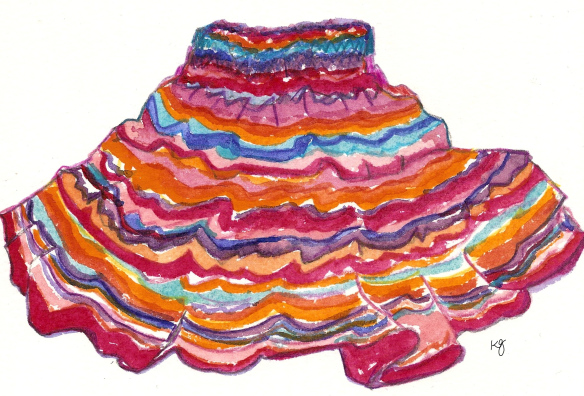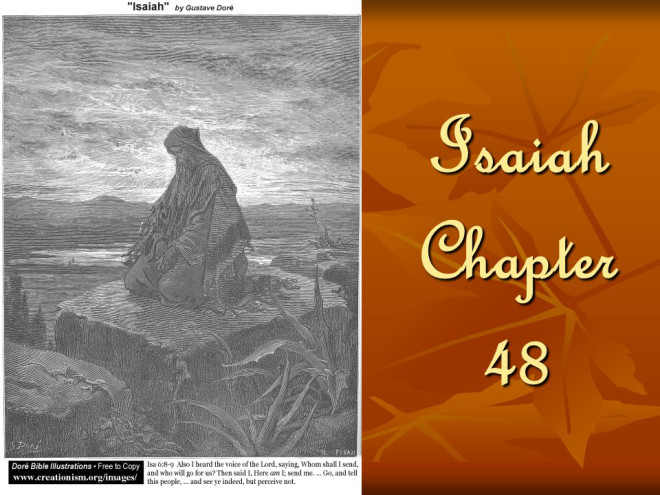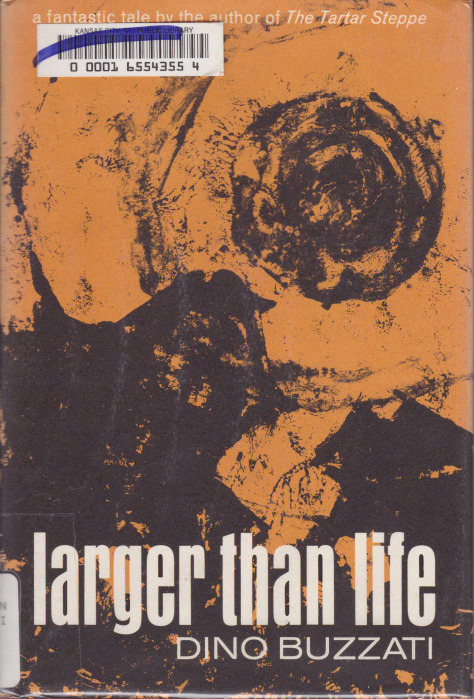Dir. Mike Leigh. Starring Timothy Spall, Dorothy Atkinson, Marion Bailey
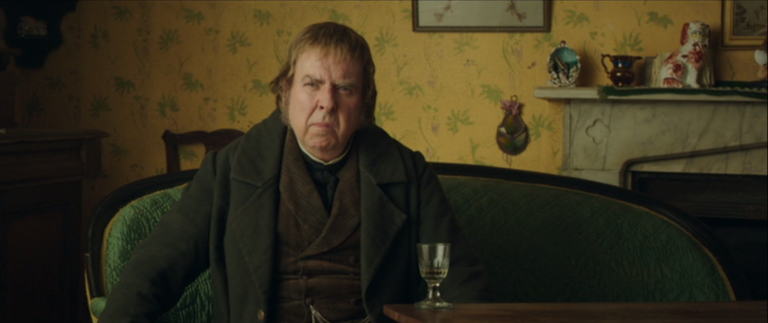
It takes a great will to make a biopic which does not lead to something. Say that Topsy-Turvy is a biopic, which I don’t know that I agree with but wouldn’t argue long about, and it is a clear case of leading up to a moment. Specifically, the movie ends not long after the premiere of The Mikado. Mr. Turner has no Mikado. No one drops by to emphasize the names of his most famous paintings, or, indeed, to give them names at all. Like a Greek epic, we begin in medias res, when Turner is already one of England’s most important painters. The movie does not answer the question of how he got there. There is no “With great power comes great responsibility” moment, and if one’s preference in a biopic is some culminating moment or forceful event, then Mr. Turner is not your daub of paint. The same goes if one wants one’s narrative film to be one’s excuse for historical knowledge or to be some signpost of accuracy. The movie is slow-moving, as apt to make a scene of buying a pig’s head for luncheon as it is to turn an art exhibition into the backdrop for a feud. One comes to know people from their quotidian activities and not from their outlier moments. Regardless of one’s opinions on Turner’s oeuvre, it seems fair to say that the character is someone we get the measure of based on what he did last Tuesday and not because he put oils on canvas.
In other words, there’s a movie about Benjamin Haydon (Martin Savage) to be made, though of course we save the “tortured artist” mystique for people who are undoubtedly good artists. Even a cursory glance at Haydon’s work reveals that on the whole he is a mixed bag. Some of it is strong-willed and powerful, where other pieces are just busy. All the same, there was a market for it in his time; the problem is with him. Haydon is sure that he is a genius being overlooked in his own time, which is obnoxious enough to watch even when the person being overlooked is a genius. (Cue Tom Hulce’s Mozart laugh.) Alas that Haydon, who is constantly short of money and who has a family besides, must suffer the indignity of not even being a member of the Royal Academy. Savage is light and slim where Spall is heavyset and plodding. Turner simply seems more likely to endure than his nervous acquaintance, whom he tolerates with some level of good humor. He lends him £50 (something like £5,000 in our currency), but Haydon is not impressed. I need one hundred pounds, he says, and even that will not erase my debt. What good will fifty do me? But he takes it all the same, marching haughtily away in a perfectly straight line from Turner’s house as some of the luckier English painters critique his art, his bedside manner. This is not a movie which indulges in other foils for Turner, and I like Haydon in that role. He is as addicted to historical drama as Turner is to boats, and as sure as Haydon is of himself, Turner is no less filled with self-reverence. All the same, one gets the sense that all which separates the two men is Turner’s gruff wit, like raw milk compared to the sour brew Haydon is passing around.
What the movie reminds me of is Thomas Young’s double-slit experiment, which was performed about twenty-five years before the movie begins. Light passes through both slits and creates imprints of different strength on the surface behind them, and the different shades are like the different Turners we see throughout the movie: the painter, the gadabout, the socialite, the critic. Yet there is no explanation for why the light should enter one slit and appear to have gone through both—at least, not for Young, who could not have understood what the photons were doing. Similarly, there is no good explanation for Turner’s deeply unusual family life, which is as defective as his paintings are charming. One can see in Turner the disinterest in a proper Victorian way of living, for he has no wife, no legitimate children. For quickies, he puts the maid, Hannah (Atkinson) up against a cabinet. It is an ugly scene; even though Hannah shows some interest, thanks to Leigh’s long view, in Turner in his life, she has no opportunity to voice her consent. He waits until the proprietress of a little place on the sea, Sophia Booth (Bailey), is widowed. Then he moves in and begins a long-term relationship with the woman he rented a room from under a false (if penetrable) name. He has a onetime mistress, Sarah (Ruth Sheen), who bore him two daughters who he does not seem to recognize as acquaintances, much less family. In the 1950s or 1960s, doubtless he would be one of those men with a second family somewhere; at the very least, he would be an adulterer. But as a single man, he can only be restless and abrupt. The tendencies of his painting—patience, dexterity, vision—are completely absent in his personal life.

Happily, those three tendencies are all about in Mr. Turner, which cannot have much competition among Leigh’s movies for the prize of “most beautiful.” Some of what he does with DP Dick Pope is cheating, really, such as a scene where Turner and Hannah put up the shades in Turner’s studio and goldenrod light coruscates in. But how about the opening sequence, set on a hillside in magnificent sunset colors as a pair of women walk by. The two of them are the vertex of a right angle where Turner, obscured in shadow (and recalling the quote attributed to him about how he’d use something blacker than black if he could find it), operates, doing his work. It is a fabulously beautiful shot as well as one that introduces us to the character himself and his aloofness. This is a Dutch scene with an English painter featured, and it’s clear that he doesn’t take people with him. He cares for his father (Paul Jesson), but does not need to bring him along. He has friends, but this is not a pleasure trip and he has no need to return to someone or to frequent a tavern with his pals. Turner is capable of pleasant conversation, but does not suffer those he finds foolish. I adore a chapter with Lesley Manville as the scientist Mary Somerville in which she magnetizes a needle by placing it in a rainbow. It is as beautiful as any other, but it also shows Turner’s natural curiosity and his rare deference. He is glad, alternately, to listen to Somerville and to wonder at her experiment, yet he is also as glad to leave the pleasantries to his father as he guides her around Turner’s paintings. A rendition of the “Pathetique” brings him over to a lady at the pianoforte; a song of Purcell’s pushes him to sing, which goes just so badly. “Remember me,” he sings, which is a word in this case that includes groaning, intoning, mumbling, and falling asleep. The short review of Timothy Spall’s performance in this movie must include his frequent grunting which more and more replaces all his speech, but whatever he does in that scene is a new sound altogether. In any event, both scenes are interesting because they feature women whom he shows great courtesy. It is in complete contrast to his behavior around other women. Films don’t have morals, but goodness knows there’s something deeply modern in our understanding of the two Turners.
The list of things which annoy Turner fills the rest of the movie, so I won’t go into it here. Suffice it to say that one of those annoyances gives the movie its keenest moment, in which Turner runs into John Constable (James Fleet) putting the finishing touches on The Opening of Waterloo Bridge Seen from Whitehall Stairs, a painting which is thoroughly red. Turner is not enamored of Constable. In front of the rest of the Royal Academy, he goes to his own painting on display: Helvoetsluys, a fairly modest seascape. He takes his brush and lays down a single red mark on a painting which is ten types of blue. The Academy is appalled. They’ve just watched a man obliterate his own work; a voice, however, says not to count out Turner’s ingenuity. He returns, wipes off a little excess red, et voilà, a buoy. It is stunning one-upmanship filled with the best qualities of that sort of thing, a little red splotch which is nerve, gall, and brilliance all in one. There’s a smattering of applause as he walks away. I wanted to as well.
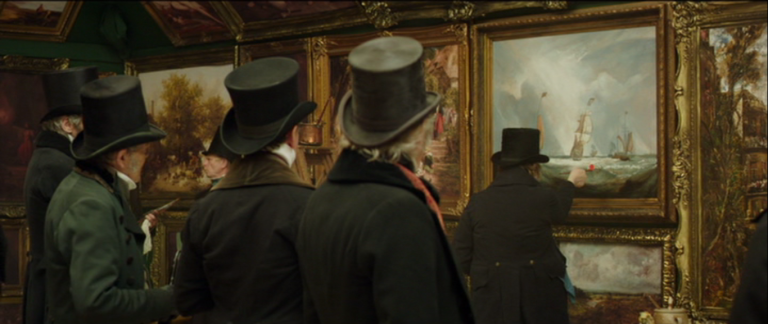
There are three scenes toward the end of the movie which I thought, at first, would be a little heavy-handed, but I wound up being pleasantly surprised by them instead. In the first, Turner wanders into a shop and has a daguerrotype made by a finicky and ebullient technician (Leo Bill). In the second, he convinces Mrs. Booth, by now moved to a little place near the Thames for Turner’s convenience, to come take one with him. In the third, Mayall takes the picture of Turner and Booth together. One expects that these scenes will be a little morbid as Turner actively engages in the practice which will come to capsize painting. But if anything, those scenes are wry. Turner does not reject the daguerrotype or complain that it lacks color and artistry. Nor does he cavil too much as Mayall takes his picture, although at this point Turner is an old and grumpy man. It is, in truth, the last thing that Turner really gets excited about, and even in his advanced age he seems willing enough to accept a future without himself or his ilk. After so many years, it’s evidence of what Turner never had in his personal life before but which he may have just discovered in time: grace.
Advertisements Share this:

